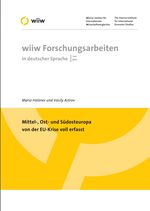Mittel-, Ost- und Südosteuropa von der EU-Krise voll erfasst
Vasily Astrov and Mario Holzner
wiiw Research Report in German language No. 2013-06, June 2013
10 pages including 5 Tables and 4 Figures
(Reprint from: WIFO-Monatsberichte, Vol. 86, No. 5, May 2013)
Zusammenfassung
2012 entwickelte sich die Wirtschaft in den Ländern Mittel-, Ost- und Südosteuropas insgesamt enttäuschend. Aufgrund der Stagnation der Exporte und der gedämpften Binnennachfrage gerieten acht Länder der Region in die Rezession (Tschechien, Ungarn, Slowenien und die meisten Westbalkanländer). In den anderen Ländern wuchs das BIP zwar, aber allgemein nur schwach. Auch in Ländern, deren Wirtschaft bisher von der Krise im Euro-Raum nicht betroffen gewesen war (z. B. Russland, Polen, Ukraine, Türkei), verlangsamte sich die Wachstumsdynamik in den letzten Monaten immer mehr.
English Summary:
Central, East and Southeast Europe Caught by the EU Crisis
On the whole, 2012 was a disappointing year for the economies of Central, East and Southeast Europe (CESEE), confirming fears of a double-dip recession in the euro area adversely impacting large parts of the CESEE region. This rather poor performance stands in sharp contrast to the better dynamics in other emerging markets in Asia and Latin America, and underscores the dependence of large parts of the CESEE region on the troubled euro area – not least in terms of policies pursued. Weak exports and suppressed domestic demand pushed nearly half of the CESEE economies into recession in 2012, including the Czech Republic, Hungary, Slovenia and nearly all Western Balkan countries. Elsewhere in the region, growth continued but was generally unspectacular. Also in countries that hitherto had been relatively immune to the euro area crisis (such as Russia, Poland, Ukraine and Turkey), growth dynamics has been progressively decelerating since the second half of 2012. The weakness of domestic demand in most CESEE countries is partly attributed to the anaemic credit dynamics, as western banks, which dominate the banking sector of most CESEE countries, are reducing their local exposure, not least in order to comply with the stricter Basel III capital adequacy requirements. In addition, the newly adopted EU fiscal pact is forcing many CESEE governments to pursue budget consolidations. High unemployment and stagnant wages, coupled with fiscal austerity and the ongoing household deleveraging, continue to weigh heavily on the dynamics of private consumption in most CESEE countries. In turn, investment activity is suppressed by the lasting perception of uncertain future prospects and underutilised capacities in an environment characterised by weak demand.
This year, economic growth in the CESEE countries is likely to pick up slightly – largely on account of somewhat less restrictive fiscal policies in some countries (Poland, Czech Republic) and a better performance of agriculture in others (Serbia, Romania), although Slovenia and Croatia will still be unable to avoid another recession. The near-term economic prospects are generally better in the eastern part of the CESEE region, which is less dependent on the troubled euro area and is in no rush (or need) to pursue fiscal consolidation. Even under the most optimistic scenario, in the medium and long term the CESEE countries will be generally unable to replicate the growth rates observed prior to the 2008-09 crisis.
Keywords: transitional economies, comparative study, economic growth, fiscal and monetary policy, macroeconomic forecast, macroeconomic analysis
JEL classification: P2, O57, E17, O4
Countries covered: Albania, Bosnia and Herzegovina, Bulgaria, Croatia, Czechia, Estonia, Hungary, Kazakhstan, Latvia, Lithuania, North Macedonia, Montenegro, Poland, Romania, Russia, Serbia, Slovakia, Slovenia, Turkey, Ukraine
Research Areas: Macroeconomic Analysis and Policy, Labour, Migration and Income Distribution, International Trade, Competitiveness and FDI
